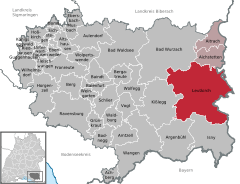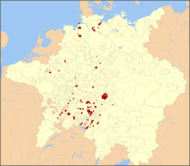Leutkirch im Allgäu
| Leutkirch im Allgäu | ||
|---|---|---|
| ||
 Leutkirch im Allgäu | ||
Location of Leutkirch im Allgäu within Ravensburg district 
 | ||
| Coordinates: 47°49′32″N 10°1′20″E / 47.82556°N 10.02222°ECoordinates: 47°49′32″N 10°1′20″E / 47.82556°N 10.02222°E | ||
| Country | Germany | |
| State | Baden-Württemberg | |
| Admin. region | Tübingen | |
| District | Ravensburg | |
| Government | ||
| • Lord Mayor | Hans-Jörg Henle | |
| Area | ||
| • Total | 174.95 km2 (67.55 sq mi) | |
| Population (2015-12-31)[1] | ||
| • Total | 22,406 | |
| • Density | 130/km2 (330/sq mi) | |
| Time zone | CET/CEST (UTC+1/+2) | |
| Postal codes | 88291–88299 | |
| Dialling codes | 07561 | |
| Vehicle registration | RV | |
| Website | www.leutkirch.de | |
Leutkirch im Allgäu is a former Free Imperial Town located in south-eastern Baden-Württemberg, Germany. It is part of the district of Ravensburg, in the western Allgäu region and belongs to the administrative region (Regierungsbezirk) of Tübingen.
Since the municipal reform of 1972, the consolidated Leutkirch urban area comprises the town of Leutkirch im Allgäu itself and the former municipalities of Diepoldshofen, Friesenhofen, Gebrazhofen, Herlazhofen, Hofs, Reichenhofen, Winterstetten and Wuchzenhofen.
History
Early history
Very few protohistoric settlement remains have been found in the Allgäu region although a grave dating from the migration period has been found in the Leutkirch area. The area was probably settled by Alemanic tribes before the establishment of the Danube-Iller-Rhine limes during the Roman period.
The town was created with the merger of the villages of Ufhofen and Mittelhofen and vestiges of those settlements were found under the old church of St. Martin. First mention of the church is found in a document of the Abbey of St. Gall dating back to 766. After the line of the local lord became extinct, the area was awarded to the counts of Bregenz and of Montfort.
Era of the Free Imperial Town
In 1293, King Adolf of Nassau granted to Leutkirch the right to rule itself according to the Town Code of Lindau (Rechte der Stadt Lindau), thus effectively raising Leutkirch to the status of a Free Imperial Town. For a while, the town continued to be ruled by a bailiff (Landvogt) appointed by the king. In 1311, there is mention for the first time of a town council (Rat) whose members are also the town judges. An elected bürgermeister (mayor) chaired the town council from the 15th century. A so-called Committee of Twenty, representing the guilds, was also part of the governing structure. Eventually, the town council was to be composed of a magistrate (Amtmann), two mayors, three secret councillors and nine councillors.

The main industry of the town then was the linen trade and the main weaver guild had a membership of 200 at one time. Their linen production was exported to Italy and Spain mostly. Leutkirch became a member of the Swabian League in 1488 and gained a seat and vote both in the League and in the Imperial Diet (Reichstag).
Like the majority of the other Free Imperial Cities, Leutkirch went through considerable internal strife during the Protestant Reformation. The town, officially Lutheran in 1546, adhered to the Augsburg Confession and later joined the Schmalkaldic League. There was a fierce dispute for several years between the Protestant magistrates of the town and the abbot of Weingarten Abbey for control over St. Martin’s parish church whose patron was the abbot. A compromise was reached in 1562: the Catholics kept the parish church while the Protestants took over the hospital’s church, which was expanded in 1589 and is now known as Memorial Church. Catholics therefore maintained a foothold and some rights in the Protestant city. In 1577 Leutkirch joined other Lutheran Free Imperial Cities in signing the Formula of Concord.

The town suffered heavily during the Thirty Years' War and the number of inhabitants fell drastically. The post-war period was not easy as well and the debt of the town continued to increase. However, difficult economic times did not prevent the town's rulers from having a new baroque town hall (rathaus) built in 1740. The stucco ceiling by Johannes Schütz remains one of the main attractions of the town. From the Peace of Westphalia onward, Leutkirch was to remain one of the smallest and least conspicuous of the 50 Free Imperial Cities of the Empire.
End of the Free Imperial Town of Leutkirch
In the course of the mediatisation of 1802-03, Leutkirch was not spared the fate of the great majority of the 50 Free Imperial Cities of the moribund Holy Roman Empire and lost its independence. The town was first annexed to the Duchy (later Kingdom) of Bavaria in 1803 before becoming part of the Kingdom of Württemberg in 1810.
Twin towns
Leutkirch im Allgäu is twinned with:
-
 Bédarieux, France, since 1982
Bédarieux, France, since 1982 -
 Hérépian, France, since 1982
Hérépian, France, since 1982 -
 Lamalou-les-Bains, France, since 1982
Lamalou-les-Bains, France, since 1982 -
 Castiglione delle Stiviere, Italy, since 1995
Castiglione delle Stiviere, Italy, since 1995

References
This article incorporates information from the German Wikipedia.



